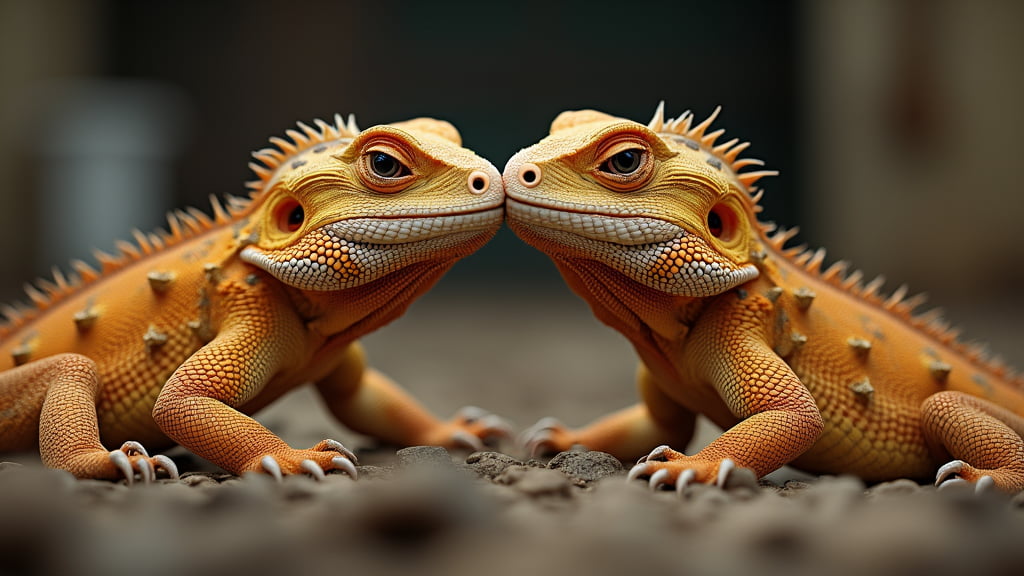Bearded dragons, often affectionately known as “beardies,” are friendly reptiles known for their calm nature and unique personalities. Having owned several bearded dragons myself, I’ve experienced first-hand the joy and challenges of interacting with these fascinating creatures. This blog post will delve into the intricacies of bearded dragon interaction with humans, offering practical advice to help you build a strong bond with your scaly friend.
Understanding Bearded Dragon Behaviour
Body Language and Communication
Bearded dragons communicate a lot through body language. Understanding these subtle cues can significantly enhance your interaction with them.
- Head Bobbing: Generally, aggressive behaviour or dominance display, especially among males.
- Arm Waving: A sign of submission. You might see this in younger dragons or those lower in the social hierarchy.
- Puffing Up: When they puff up their beards and darken them to almost black, it’s a sign they’re feeling threatened or stressed.
Mood and Temperament
Beardies are generally docile but have individual personalities. Some might be more adventurous, while others are shy. Observing their behaviour and responding accordingly builds trust.
- Curious and Active: A healthy, happy bearded dragon is usually alert and curious.
- Hiding and Inactivity: While not always a cause for concern, this could indicate stress or health issues. Make sure to consult with a vet if you notice prolonged changes in behaviour.
Building Trust and Bonding
Handling Your Bearded Dragon
Proper handling is crucial in building a trusting relationship. Here are some tips from my own experience:
- Start Slowly: Initially, limit handling sessions to a few minutes a day. This helps them get accustomed to your presence.
- Support Their Body: Always support their full body, ensuring their legs are well-supported. This prevents them from feeling vulnerable.
- Consistent Interaction: Regular handling will help your bearded dragon become more comfortable with you over time.
Creating a Comfortable Environment
Your bearded dragon’s habitat significantly impacts their interaction with you:
- Proper Lighting and Temperature: Ensure your bearded dragon’s enclosure mimics their natural environment with appropriate UVB lighting and temperature gradients.
- Safe Space for Exploration: Allowing your bearded dragon some supervised time outside their enclosure can be beneficial. A pet-friendly room or a designated play area helps them feel secure and engaged.
Positive Reinforcement
Using treats and gentle interaction can reinforce positive behaviour and strengthen your bond:
- Offering Food: Hand-feeding treats such as fruits or insects can create a positive association.
- Calm Behaviour: Rewarding your bearded dragon when they are calm and relaxed can encourage trust.
Common Challenges and Solutions
Overcoming Fear and Stress
Even the most well-adjusted bearded dragon can experience fear or stress. Here’s how to manage it:
- Gradual Exposure: Introducing new people or environments slowly can minimise stress.
- Consistency: Keeping a consistent routine helps your bearded dragon feel secure. Feeding and lighting schedules are crucial.
- Quiet Environment: Loud noises and sudden movements can startle your bearded dragon. A calm setting is best.
Health and Well-being
While this section deals primarily with interaction, remember that health impacts behaviour immensely. Always consult a vet if you notice:
- Changes in Eating Habits: Sudden lack of appetite can be a sign of underlying health issues.
- Abnormal Behaviour: Lethargy or hyperactivity, persistent hiding, or aggression can indicate stress or illness.
Travel and Relocation
Moving or travelling with your bearded dragon can be stressful for them, but with proper preparation, it can be managed:
- Travel Containers: Use secure, well-ventilated containers for transport.
- Comfort Items: Having familiar items like a favourite rock or piece of cloth can help soothe them during travel.
Conclusion
Interacting with your bearded dragon can be a rewarding experience, creating a deep bond between you and your scaly companion. By understanding their behaviour, creating a comfortable environment, and using positive reinforcement, you can ensure a happy and well-adjusted bearded dragon. Remember, consistency, patience, and a gentle approach are key to building trust and connection with your bearded dragon.
For more information about bearded dragon care, check out our detailed guide on Bearded Dragon Behaviour Problems. And for a community of fellow bearded dragon enthusiasts, visit Bearded Dragon Forum.
By following these steps and embracing patience and consistency, you’ll be setting the stage for a delightful relationship with your bearded dragon. Enjoy the unique company these fascinating creatures have to offer!
Click here for products to enhance your bearded dragon’s habitat and care.

